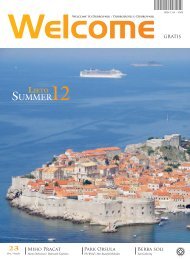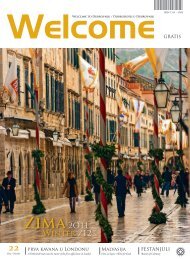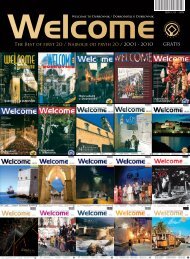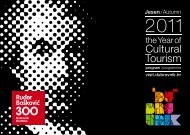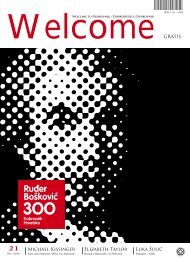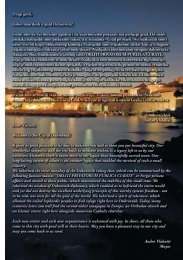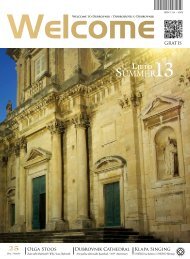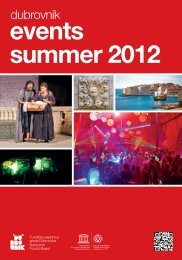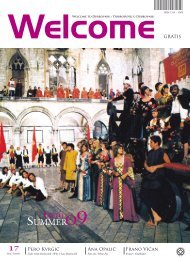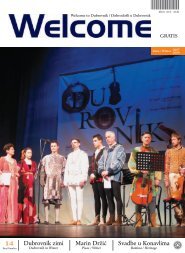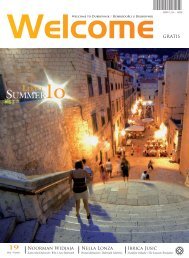WELCOME Magazine 16 - TuristiÄka zajednica grada Dubrovnika
WELCOME Magazine 16 - TuristiÄka zajednica grada Dubrovnika
WELCOME Magazine 16 - TuristiÄka zajednica grada Dubrovnika
Create successful ePaper yourself
Turn your PDF publications into a flip-book with our unique Google optimized e-Paper software.
se, ozbiljne i stišane, tek ovlaš zagledivale<br />
u svoju sliku, onda kad su se rasplitale<br />
pletenice, a niz lice se spuštale vlasi,<br />
zakovrčane, mirisne po materinstvu i<br />
tajnovitosti davanja. Gledale su se i u<br />
borama godina, blage, pune darova.<br />
Po nekom su se prenesenom vjerovanju<br />
kredence smatrale izlogom bogatstva, a<br />
burali intimnim mjestima koja izmiču<br />
očima dolaznika. I jedni su i drugi imali<br />
svoje mirise. U kredencama se osjećao<br />
dah rozulina i cimetni ćuh mantale, pa<br />
reski, slatki morač i prštava lovorika iz<br />
suhih smokava.<br />
Iz burala je mirisalo rublje po dječjim<br />
tijelima, po ruži stolisnici, bosioku,<br />
naftalinu i narančinoj kori.<br />
I jedni i drugi su se držali čovjeka i na<br />
njihovim se drvenim tijelima primjećivalo<br />
kako se ljudska ruka često doticala<br />
vrata, kako je ostavila trag prstena i životnih<br />
pokreta dok su se predmeti i ljudi<br />
družili. Tako je namještaj vremenom<br />
nosio sliku gospodara, a ljudi, svjesni<br />
prolaznosti, unosili u ove starinske čekače<br />
znak svoga duha i zvuk kojim su se i<br />
nakon odlaska javljali ukućanima.<br />
Cupboards<br />
and Chest of<br />
Drawers<br />
Cupboards once stood in drawingrooms<br />
like house shop-windows.<br />
They were usually imported from faraway<br />
lands, when the local masters were<br />
not proud of fine manufacture. Their<br />
wood was carefully selected, so that<br />
some smelled of sour cherry, those made<br />
of beech-wood gleamed yellow, while<br />
the veins of those made of walnut-wood<br />
ran along their sides from top to bottom,<br />
reflecting the growth of the tree in<br />
rain and summer seasons.<br />
The lower part of these salon cupboards<br />
resembled a closed little house, filled<br />
with tableware and food, whereas the<br />
upper part was like a window in which<br />
the house exhibition mirrored. In it one<br />
could see porcelain plates and bowls,<br />
cups with flower ornaments or golden<br />
edging, and palm leaves and olive<br />
branches inserted in the teapot opening.<br />
The cupboard glass was crystal-clean<br />
and tiny, reminiscent of the miniature<br />
windows in old houses, and the housekeeper<br />
made sure that the finest house<br />
treasure was display was behind it. The<br />
precious exhibits included a Christmas<br />
Bambino doll, Japanese folding fan,<br />
Murano glass vase and a fragile little<br />
sheep on glass legs. Beside them stood a<br />
porcelain chimney sweeper, shepherdess<br />
and a ballerina performing a pirouette<br />
on her ballet-shoe tips.<br />
Against the open part of the cupboard<br />
without glass, which offered many possibilities,<br />
a tray usually leaned. In front<br />
of it stood a soup-bowl filled with fruit,<br />
and in the passages, within reach but<br />
neatly arranged, the family photographs<br />
shone. The small size frames contained<br />
the single Photo Rex photographs of<br />
grandmother and grandfather in folk<br />
costumes on their wedding day, and portraits<br />
of the children if front of Orlando’s<br />
Column surrounded by the pigeons<br />
flying or skipping on the stone slabs,<br />
caught in time by the photographer.<br />
The chest of drawers came to the<br />
house from faraway places and time.<br />
They were the wooden firm commodes<br />
with four drawers, and their smooth<br />
and warm surface was usually covered<br />
with a white napkin. The house was<br />
evaluated by the richness and number<br />
of cupboards and chest of drawers<br />
in the rooms. The number of pieces<br />
matched the attention paid to the family<br />
history with reminiscences of bed<br />
linen and both holiday and workdays<br />
underclothes. It was the time when the<br />
grandparents’ clothes were carefully<br />
kept in silk paper, and when village and<br />
city women were dressed in a different<br />
way, wearing long dresses and lace<br />
shawls around their necks, and when<br />
their chest of drawers also contained<br />
bodices, underskirts, handkerchiefs, lace<br />
and crocheted napkins.<br />
The chest of drawers were usually dark<br />
brown, shining with a noticeable glow,<br />
and revealing the trouble which their<br />
maker took to polish the noble wood<br />
with such skill that one could see a<br />
reflection of his face on the thin coat of<br />
furniture varnish. The drawers were also<br />
not of the usual type, but elongated and<br />
spacious, with the ornamented brazen<br />
handles that glowed discretely.<br />
In the evening, before bed time, some<br />
of the household members placed an oil<br />
lamp on the bureau, extremely carefully<br />
in order not to spill the oil on the white<br />
napkin. It resembled a cheerful and<br />
well-intentioned eye that watched the<br />
room, bed, wooden floors, old-fashioned<br />
wardrobe in the corner, patchwork carpet,<br />
veins in the board and the pictures<br />
of the Sacred Heart and Virgin Mary<br />
smiling from the wall with cast down<br />
eyes and watching over those who entered<br />
as children and left as old people.<br />
Everybody passed by the old chest of<br />
drawers, stopping for a while, because it<br />
was customary to place a house mirror<br />
above it. In the semi-darkness of the<br />
room, by the dim oil-lamp light, they<br />
watched the reflections of their faces in<br />
the mirror as the years went by. While<br />
the little heads of the children hardly<br />
reached the third drawer, the girls<br />
admired their oval faces and glow in<br />
their eyes reflected in the mirror. Stern<br />
and quiet their mothers watched their<br />
reflections only hastily, when disentangling<br />
their hair gathered into braids<br />
that curled down their faces smelling of<br />
motherhood and the secrecy of giving.<br />
Gentle and nurturing, they watched the<br />
wrinkles that came with the old age.<br />
The cupboards were believed to be the<br />
shop windows of wealth, and the chest<br />
of drawers the intimate places hidden<br />
from the eyes of the visitors. Both had<br />
their own fragrances. The cupboards<br />
smelled of rozulin and mantala sprinkled<br />
with cinnamon, the tart sweet fennel<br />
and the crackling bay leaves from dried<br />
figs. The underwear from the chest of<br />
drawers smelled of children’s’ bodies,<br />
cabbage-rose, basil, mothballs and<br />
orange peel. The cupboards and chest<br />
of drawers both served the man, and on<br />
their wooden bodies one could notice<br />
the marks of the human hand which frequently<br />
opened the doors, leaving traces<br />
of ring and life motion while the objects<br />
and people were friends with each other.<br />
Thus the furniture reflected the images<br />
of its owners in time, while the people,<br />
aware of the passage of time, had filled<br />
these old waiting objects with the marks<br />
of their spirit and with the sounds which<br />
the household members also heard after<br />
their departure.<br />
Wel c o m e to Du b r o v n i k 35



